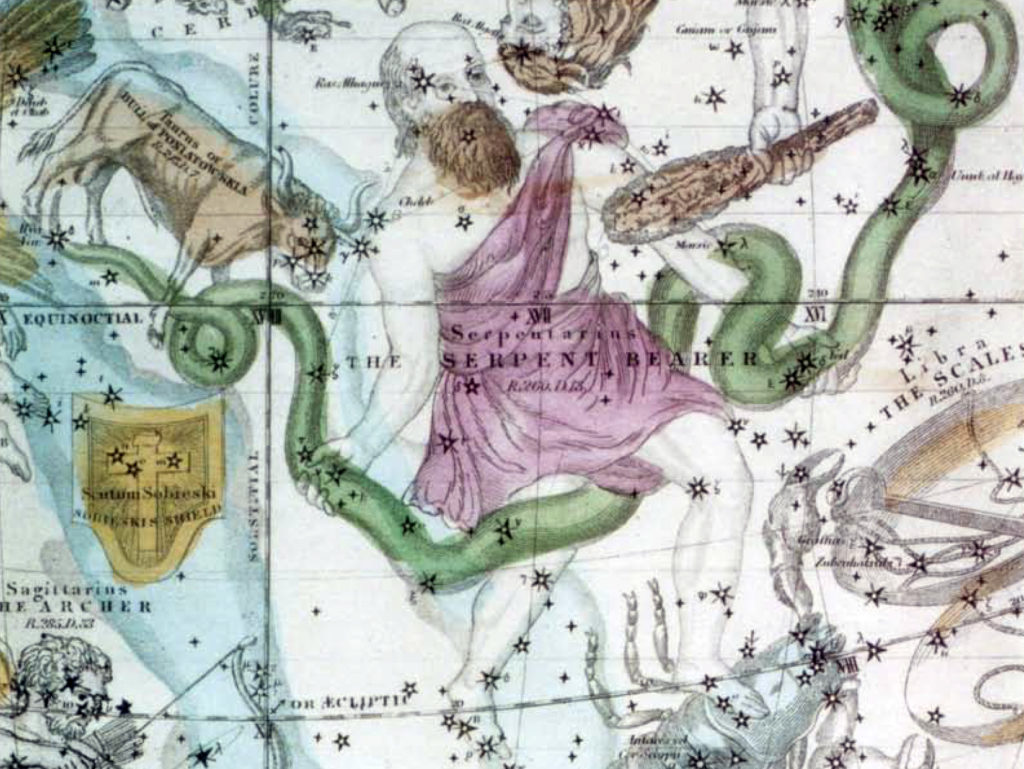Sky Report: October 25- October 31

Ophiuchus in a 19th century atlas. Constellation boundaries are not shown but the ecliptic is, at bottom. Venus is presently traversing his foot.
The three bright planets visible tonight are Jupiter and Saturn in Capricornus and Venus in Ophiuchus. Ophiuchus? Yes, it’s the “13th constellation of the zodiac” and Venus is within its boundaries from October 21 until November 1 before moving on to Sagittarius. You can see Ophiuchus in the southwest during the early evening.
When the sky was divided into constellations millennia ago, early astronomers paid particular attention to the star groups that the moon and planets pass through. There are about 12 lunar months in a year (12 full moons) so they divided the sky into 12 sections, or signs. Many were animals, like the Bull and the Lion, so the 12 were known as the zodiac for “circle of animals”. But the constellation boundaries have evolved; for example what was once the Claws of the Scorpion is now Libra the Scales. According to the way modern astronomers divide the sky, after passing through Scorpius, Venus transits southernmost Ophiuchus on its way to Sagittarius. Ophiuchus is the Serpent Bearer, and his serpent is the rod of the healer Asclepius (Google it) and the two-part constellation Serpens (green on the attached star chart). All the planets plus the sun and moon invariably pass through Ophiuchus from time to time so this is hardly unusual. (Google “Ophiuchus 13th constellation”.).
The sun passes through Ophiuchus too, from November 29 through December 17.
Telescopically Venus looks like a tiny first-quarter moon, but use high power — at least 50X — because Venus appears to be only 1/80th the diameter of the moon. Venus is approaching the earth so it will grow larger telescopically and become a slimmer crescent in weeks ahead.
Jupiter and Saturn are to the left of Venus and the three form a nice line in the sky. Jupiter is not quite as bright as Venus and fainter Saturn is between them and ¼ of the way from Jupiter to Venus.
Uranus and Neptune are out these evenings too, in Aquarius and Aries respectively, and you can see them in any telescope and even binoculars if you know precisely where to look. The best way to find them is to use an inexpensive planetarium app on your smartphone or tablet; my favorite is SkySafari but there are several that will do the job. That same app will verify that the sun passes through Ophiuchus in early December.
Under a grant from the Utah Governor’s Office of Economic Development and the Kane County Office of Tourism, Stellar Vista Observatory offers portable telescopes and tripod mounted binocular kits on loan for free to all residents of Kane County. Nothing beats a quality binocular or astronomical telescope to enhance enjoyment of the night sky! Visit https://stellarvistaobservatory.org/discover-the-night-sky/ or Kanab City Library for full details.
The Sky Report is presented as a public service by the Stellar Vista Observatory, a nonprofit organization based in Kanab, Utah, which provides opportunities for people to observe, appreciate, and comprehend our starry night sky. Additional information is at www.stellarvistaobservatory.org. Send questions and comments to John@StargazingAdventures.org.






Comments are closed.